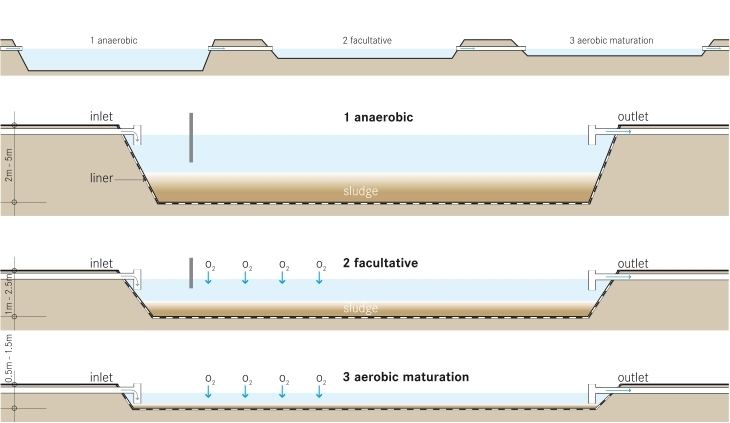 | ||
Stabilization ponds (also called lagoons or waste stabilization ponds) use a natural process for wastewater treatment that employs a combination of macrophytic plants, substrates and microorganisms in a more or less artificial pond to treat wastewater. The technique is frequently used to treat municipal wastewater, industrial effluent, municipal run-off or stormwater. After treatment, the effluent may be returned to surface water or reused as irrigation water (or reclaimed water) if the effluent quality is high enough
Contents
Stabilization ponds are commonly used for wastewater treatment in developing countries. Types of treatment ponds include settling basin, anaerobic lagoons, facultative pond and aerated lagoons.
Wastewater Stabilisation Ponds is the collective term for a system of ponds used in wastewater treatment, including:
Technology
Stabilization ponds consist of man-made basins comprising a single or several series of anaerobic, facultative or maturation ponds. The primary treatment takes place in the anaerobic pond, which is mainly designed for removing suspended solids, and some of the soluble element of organic matter (BOD). During the secondary stage in the facultative pond most of the remaining BOD is removed through the coordinated activity of algae and heterotrophic bacteria. The main function of the tertiary treatment in the maturation pond is the removal of pathogens, although it also assists in nutrient reduction (i.e. nitrogen).
Removal of pathogens
A study of ten stabilization ponds in Honduras has shown that they were effective in removing helminth eggs, a pathogen, from the effluent and to satisfy the World Health Organization microbiological guidelines for Category B irrigation with wastewater effluent. However, sludge from all ponds was heavily contaminated with helminth eggs.
Application and suitability
Stabilization ponds are particularly well suited for tropical and subtropical countries because the intensity of the sunlight and temperature are key factors for the efficiency of the removal processes. A current study (2016) by scientists from the Institute of Environmental Science & Research in New Zealand showed however that similar levels of removal of indicators and viruses can be achieved independent from sunlight, if the pH and dissolved oxygen levels remain elevated. It is also recommended by the WHO for the treatment of wastewater for reuse in agriculture and aquaculture, especially because of its effectiveness in removing nematodes (worms) and helminth eggs.
Stabilization ponds, as described here, use no aerators. High-performance lagoon technology with aerators has much more in common with that of activated sludge. Such aerated lagoons are common in small towns in the United States, among other places.
Costs
Stabilization ponds are widely regarded as the most cost-effective wastewater treatment technology for the removal of pathogenic micro-organisms. A World Bank study carried out in Sana’a, Yemen, in 1983 makes a detailed economic comparison of waste stabilization ponds, aerated lagoons, oxidation ditches and trickling filters. According to this study, stabilization pond technology is a cheaper option up to a land cost of US$ 7.8 per square meter. Above this cost, oxidation ditches become the cheapest option. However, often the main constraint against selecting this technology is not land cost but land availability. If land is available, stabilization ponds have the advantage of very low operating costs since they use no energy compared to other wastewater treatment technologies.
Use
Stabilization ponds are used for municipal waste water treatment in many countries with ample sunshine, including Colombia, El Salvador, Guatemala, Honduras, Israel, Jordan, Morocco, Nicaragua, Tunisia and Uganda. They are typically used in smaller towns where land availability and cost is less of a constraint. In some cities larger stabilization ponds have been replaced in the early 2000s by activated sludge waste water treatment plants, such as in Amman (Jordan) and in Adelaide (Australia) in 2004.
